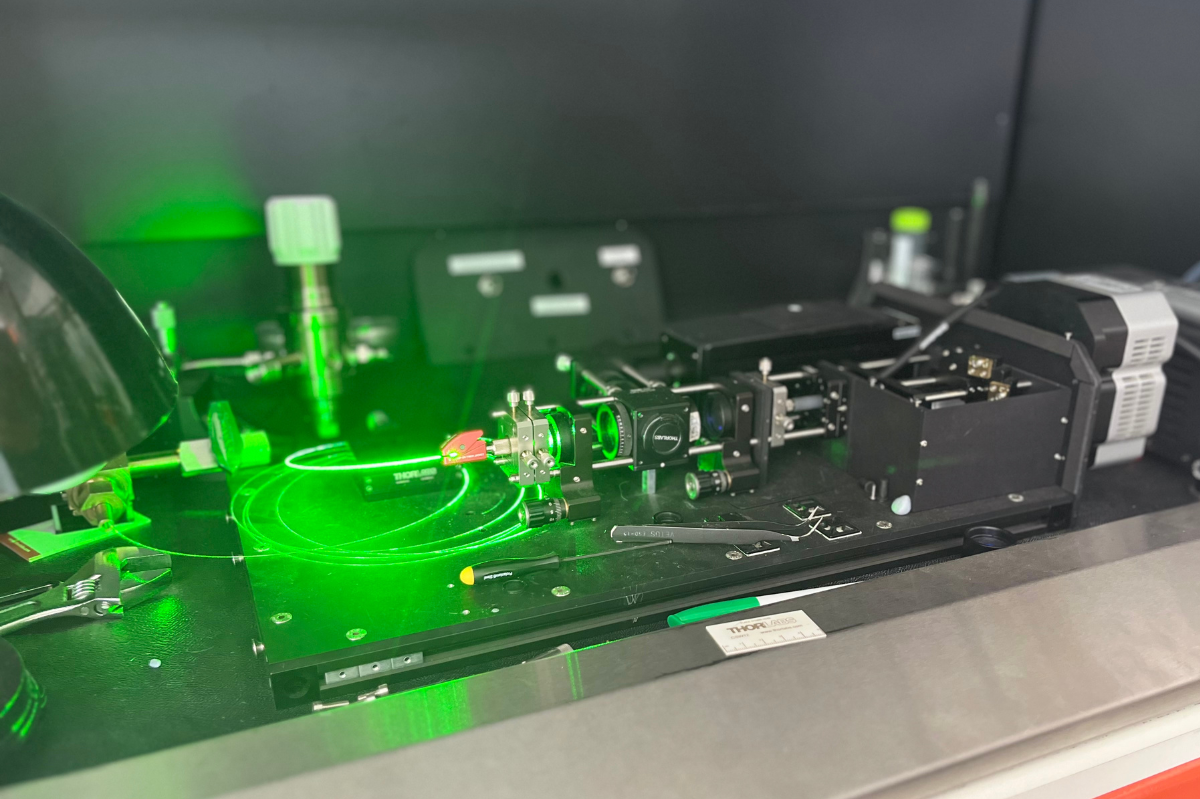IS-Instruments is proud and delighted to announce that members of our team have been awarded a patent for a Gas-phase Raman instrument for detecting gas species using a hollow core fibre.

Image Credit: IS-Instruments, Ltd.
The Challenge:
Raman spectroscopy is a powerful tool for identifying and quantifying unknown substances. All molecules provide a unique spectral fingerprint that can be measured, and various instruments have been developed that observe solid and liquid samples.
Making Raman observations of gases is a significant challenge due to the small scattering cross-section of gaseous molecules. This is particularly true for samples from gas pipelines, where a significant number of species can be present at various concentrations. Observations of gases at concentrations below 3% and down to parts-per-billion (ppb) levels are beyond the capability of current systems.
One method for increasing the effectiveness of an instrument is to increase the path length of interaction between the laser and the gas species, which gives a stronger Raman signal, and one way of increasing the path length is using hollow core micro-structured optical fibres (HC-MOFs).
The Solution:
The gas sample is contained in an HC-MOF in optical communication with a monochromatic light source. A detector in optical communication with the fibre detects a Raman signal from the gas sample. A mask is mounted between the fibre and the detector to attenuate one or more selected frequencies of the Raman signal. The filtered signal may be used to identify one or more low-concentration components of the gas sample. The one or more selected filter frequencies may correspond to the Raman spectrum of one or more components of the sample that are present in high concentration. The mask may comprise a variable filter which is dynamically controllable. The detector may comprise a plurality of CCD detector pixels, each detecting a specific frequency of the Raman signal, and the mask attenuates the light reaching one or more selected pixels of the detector selected by calibration or simulation. The gas may be natural gas, and the selected frequencies may correspond with methane. The apparatus may be mounted in a portable unit.
The full details of the instrument can be found here.
The Inventors:
Dr Michael Foster completed his PhD in 1999 in the study of cometary atmospheres. Due to his interest in instrumentation, he moved into LIDAR and remote sensing. He has played a pivotal role in several space LIDAR projects, including designing filtering solutions for EarthCARE, ADM (Aeolus) and Ascope missions.
Dr Foster is recognised as a leading UK expert in LIDAR instrumentation and has worked with several research groups, including University College London, Imperial College London, the University of Leicester, The Open University and the University of Southampton.
 After completing a degree in Physics and a PhD in Space Plasma Physics at the University of Leicester, Jon entered the world of optical instrumentation. Since then, he has been responsible for designing and building every element of optical and laser-based instruments for various applications, ranging from the highest specification optical filter and 3D landing LIDARs for the European Space Agency to a gas contaminant sensor for British Gas.
After completing a degree in Physics and a PhD in Space Plasma Physics at the University of Leicester, Jon entered the world of optical instrumentation. Since then, he has been responsible for designing and building every element of optical and laser-based instruments for various applications, ranging from the highest specification optical filter and 3D landing LIDARs for the European Space Agency to a gas contaminant sensor for British Gas.
His wide range of skills means he is involved in the initial design of a system, specifically the optical, mechanical and software elements, through assembly and testing before delivery.
Dr Will Brooks received his B.Sc (Hons) degree in Chemistry in 2006 from the University of Wales, Bangor and obtained a PhD in Electronic Engineering from Bangor University in 2012, studying spatially resolved performance characteristics of thin-film CdTe photovoltaic solar cells. Following this, Will took up a postdoctoral position at the Centre for Solar Energy Research at Glyndwr University, working as Research Assistant on a Welsh Government Academic Expertise for Business (A4B) Collaborative Industrial Research Project (CIRP).
Charles completed a Masters’s Degree in Physics at the University of Exeter in 2014. His particular research area related to Raman spectroscopy of graphene, a revolutionary new material with potential applications in various industries and technologies. During his work on graphene, he gained experience in cleanroom protocols and optical lithography. After his degree, Charles completed a PGCE at the University of Exeter and achieved a teaching scholarship from the Institute of Physics. He spent some time as a science teacher specialising in physics before returning to research and development.
The University of Southampton’s Optoelectronics Research Centre
Natalie received her PhD from the University of Bath in 2011 on fabricating and integrating hollow core microstructured optical fibres (HC-MOFs) for use as gas cells in applications including frequency metrology and slow light. In 2010, she started as a Research Fellow at the Optoelectronics Research Centre (ORC) at the University of Southampton, initially working on fabricating HC-MOFs for telecommunications applications. She has designed and fabricated state-of-the-art HC-MOFs, in terms of loss and bandwidth (both bandgap-guiding and anti-resonant type). These fibres have been used in world-leading transmission experiments, highlighting the potential of HC-MOFs in future high-capacity transmission networks and in novel demonstrations for ultra-high power delivery. She has also led the fabrication of HC-MOFs for operation in the mid-IR spectral region and demonstrated an order-of-magnitude loss reduction compared to previous examples in the literature. She also has a strong interest in gas-filled applications of HC-MOFs and completed the first study into the origin and concentration of gas species that are found in HC-MOFs post-fabrication and, using HC-MOFs for the Mid-IR, published the first realisation of sub-ppm sensitivity in gas-filled HC-MOF.
Matthew Partridge
Matthew Partridge received a BSc in biochemistry from Lancaster University, Lancaster, and his PhD from Cranfield University in 2014 on developing fibre optics into molecular sensors. In 2018, he joined Southampton University, Southampton, U.K., and worked on the applications of microstructure fibre in sensing applications. Since 2020, he has been running the science communication website ErrantScience.com and is the Technical Director with Orlef Ltd., a company specialising in point-of-care diagnostics.
IS-Instruments is a growing SME based in Tonbridge, Kent, specialising in spectroscopy, particularly in designing instruments for making Raman measurements. The company was co-founded in 2010 by Directors Dr Michael Foster and Dr Jonathan Storey with Nicholas Bantin. The Directors are renowned worldwide as experts in Optical filtering systems, Laser-enhanced remote sensing instrumentation, Photon Counting Techniques and High-precision interferometry. Michael and Jon have ten years of experience working with LIDAR and 3D vision systems for space-borne applications and are internationally respected in the community. ISI’s core business is designing and developing remote sensing instrumentation for hostile and high-temperature environments, such as Nuclear, Defence, and the so-called Foundation Industries.